There are many ways to clean your leather seats, but these methods have varying levels of success. The first thing you need to do is decide which type of leather you have on your seat.
There are two types of leather seats:
- Perforated leather is the more common type found in cars today because it has a “breathable” feel to it;
- Non-perforated leather is not as popular because it traps heat and moisture, which can lead to mold problems down the line;
In this blog post, we’ll explore how you can keep your perforated leather from looking dirty or from wearing out prematurely.
Steps on Cleaning Perforated Leather Car Seats:
1) Get rid of all the loose dirt with a vacuum cleaner
If the dirt is only on the surface, you can easily get rid of it using a vacuum cleaner. Make sure to use the crevice tool to clean in between the seats and around the edges [1].

2) Wipe the seats
If there is any dried-on mud or food, you can try to remove it with a damp cloth. Be careful not to saturate the leather though, as this could cause damage.
3) Test out your chosen leather cleaner
Leather is a delicate material, so it’s important to take great care when cleaning it. Before applying any cleaner to the seats, test it out on an inconspicuous area first. This will help you to gauge how harsh the cleaner is, and whether it will cause any damage or discoloration.
4) Apply the cleaner and scrub
If you have a leather cleaner that you know and trust, then go ahead and apply it according to the manufacturer’s directions. However, if you don’t have one or would rather not use one, there are plenty of natural alternatives that can be just as effective.
For a more intensive clean, you can also make a paste out of baking soda and water. Apply this to the seats using a cloth or sponge, then leave it to work its magic for a few minutes before rinsing off with warm water.
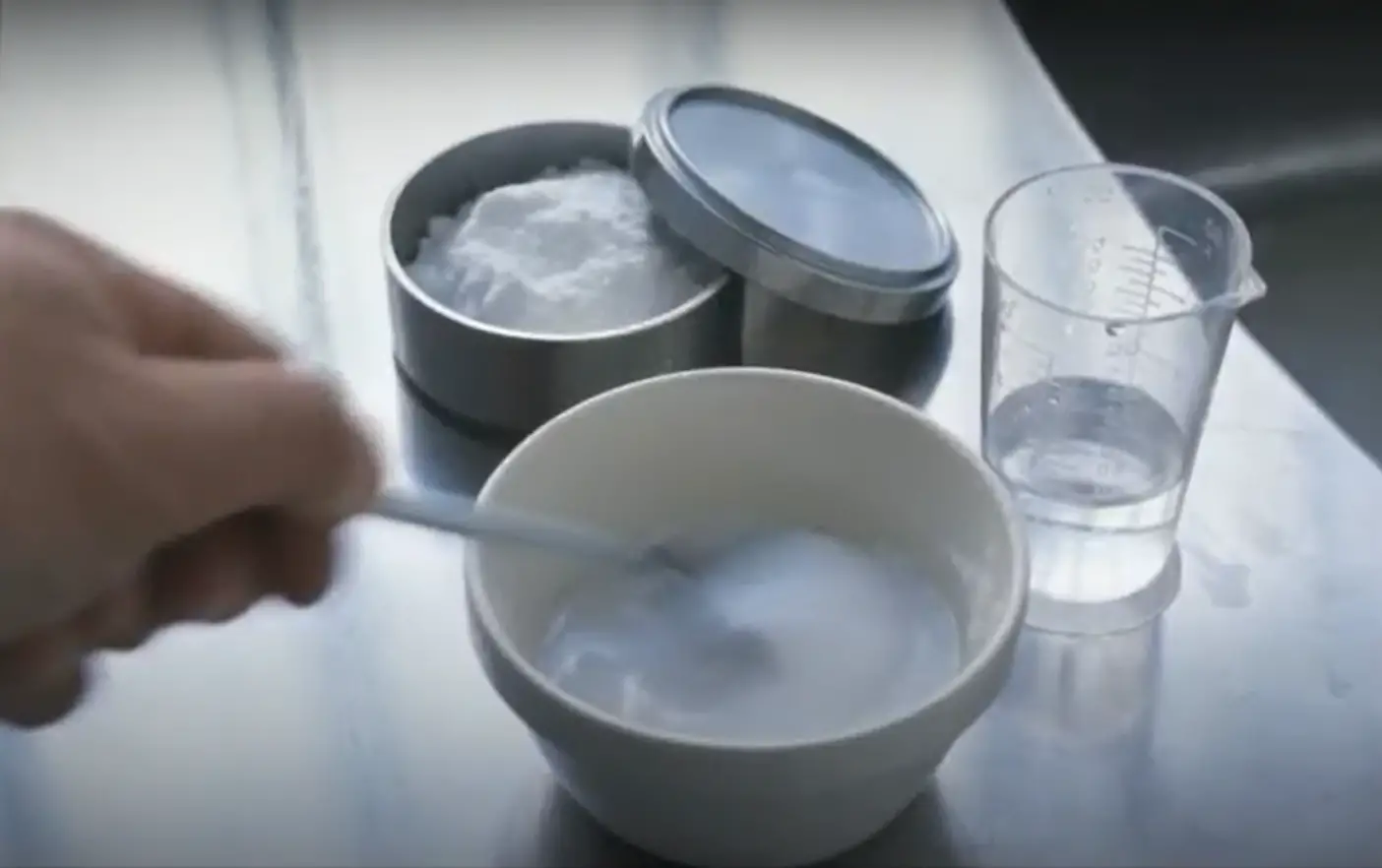
Alternatively, you could use olive oil – just dab some onto a soft cloth and massage into the leather. Leave it to soak in for a while before wiping off any excess.
5) Wipe the seats down with a microfiber towel
Once you’ve cleaned the seats, it’s important to dry them off properly. A good way of doing this is to use a microfiber towel – these are designed to absorb moisture quickly and without leaving any streaks behind.
Give the entire seat area a good rub down with the towel until it’s completely dry. If you notice any areas that are still damp, go over them again until they’re no longer wet.
6) Condition the leather to rehydrate it
Once you’ve cleaned and dried the seats, it’s a good idea to condition them as well. This will help to rehydrate the leather, which in turn can make your car interior look sleeker, healthier, and more luxurious than before!
A simple way of doing this is by using Vaseline or butter. Simply apply some onto a clean cloth and massage into the seating area until fully absorbed.
Leave on for an hour or two so that all of the moisture has time to soak through properly. After this point, simply wipe off any excess with another microfiber towel. You should find that your leather feels soft and supple once again!
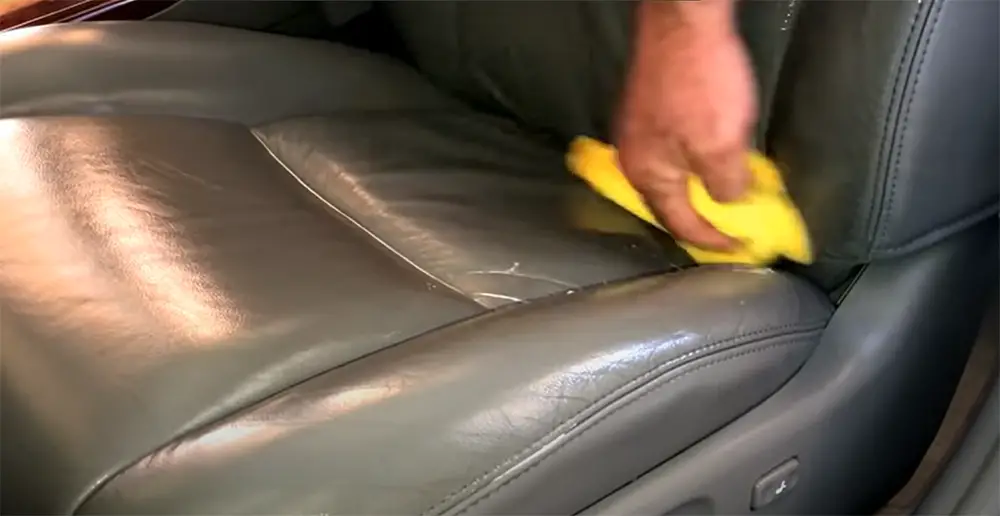
7) Wipe and dry the leather seats again
Once you have conditioned the leather, it’s important to give them another wipe and dry afterward. This will help to lock in as much moisture as possible, which will make your seats feel soft and supple for longer!
Here are a few things that cleaning experts recommend:
- Use a microfiber towel (or any other kind of cloth);
- Don’t use paper towels or napkins, as they can leave behind streaks and lint;
8) Buff and polish with a new microfiber towel
The final stage of the cleaning process is to buff and polish your seats:
- Get yourself another microfiber towel (or two if you want);
- Fold it into quarters so that there are four separate sections;
- Apply some leather conditioner onto one section only rub this very lightly over the entire seating area until it becomes fully absorbed;
- Use another quarter of the cloth to wipe away any excess conditioning;
- Repeat again using more fresh towels;
- To finish off, use yet another clean towel to give everything a light buff. Once done, make sure that all areas have been properly dried;
Additional Tips For Cleaning Tiny Holes:
1) Use an air compressor
If you’re a car detailer, an air compressor is an excellent piece of equipment to have (both professional and hobbyist). It’s useful in a variety of situations, particularly when cleaning perforated leather seats [2].
A word of caution – make sure that you don’t point the air compressor directly at your seats, as it could damage the leather over time. Angle it slightly so that the force of the air is directed downwards instead.
2) Use a toothpick, interdental brush, or gum stimulator
If you don’t have an air compressor, then there are a couple of other things that can be used to clean perforated leather seats.
For example, if you want to get into the really small holes (under 0.07 inches), a toothpick might do the trick – but only when conditions permit! Make sure that your seat isn’t brand new and has already been conditioned several times beforehand. Otherwise, it could cause tiny tears on the leather’s surface which will eventually become larger.
Similarly, interdental brushes or gum stimulators can also help to clear out any debris from hard-to-reach areas – although they’re not as effective at removing hardened dirt buildup like waxes and polishes.
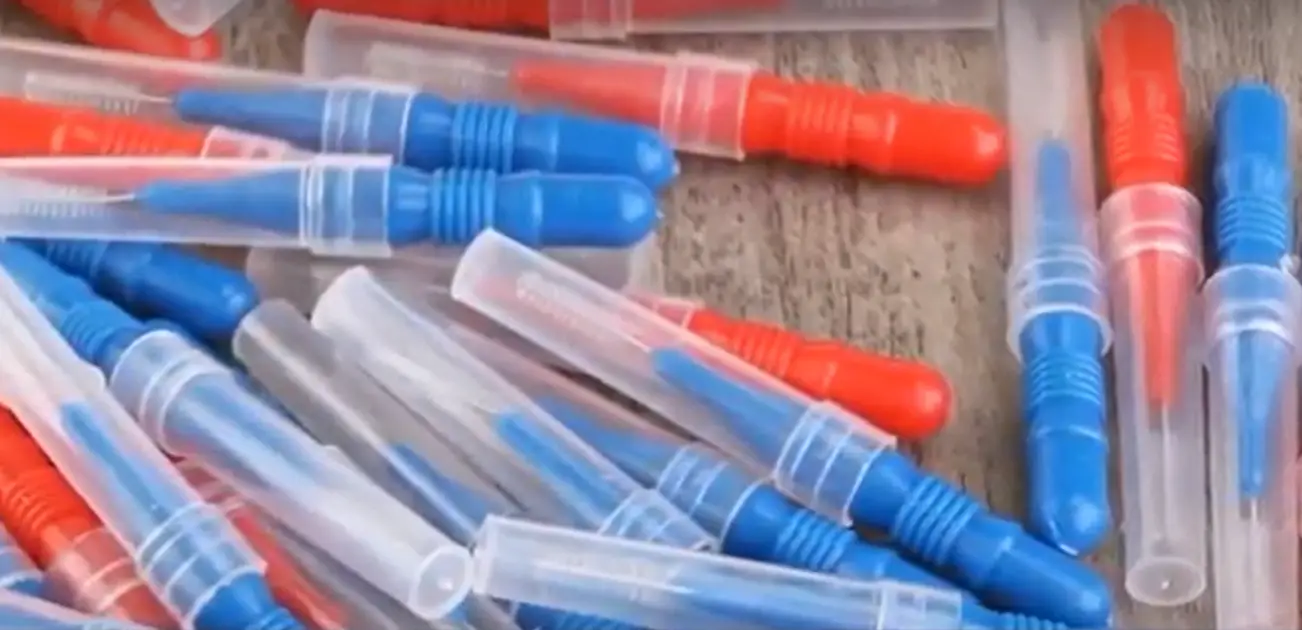
3) Use a steam cleaner
If you have a steam cleaner, this can be used to blast out any dirt or grime that’s built up inside the tiny holes. Make sure that you use a gentle setting – and if possible, try not to hold the nozzle too close to the leather.
4) Use a very thin vacuum nozzle
If you have a vacuum cleaner with a very thin nozzle attachment, this can also be used to clean the perforated leather seats. Be careful not to put too much pressure on the seat though, or you might damage it.
How To Remove Odor From Perforated Leather Car Seats?
With leather cleaner alone, smells from vomit, urine, or forgotten food might be difficult to remove. If the leather cleaner doesn’t eliminate the noxious smell from your car after applying it once again, try mixing a solution of one part water and one part white vinegar in a spray bottle.
Spray the afflicted region of your seat with a fine spray and allow to sit for 5 minutes to soak into the holes. Wipe away any dampness using a clean cloth if necessary. If required, repeat until the stench is removed [3].
Alternatively, you can use a commercial odor eliminator. These products work to remove any malodors from the surface of your car seats and leave behind a pleasant scent. Simply follow the directions on the bottle to apply and allow it to dry. Once it is completely dry, your car will smell fresh once again!
If you’re looking for a more natural solution, baking soda can be used as an effective deodorizer. Sprinkle a liberal amount over the soiled area of your seat and let it sit overnight. The next morning, vacuum up the leftover baking soda and dispose of it in the trashcan outside. Baking soda is also great for removing tough stains from leather car seats – just make sure to test it in an inconspicuous spot first to ensure that it doesn’t cause any discoloration.
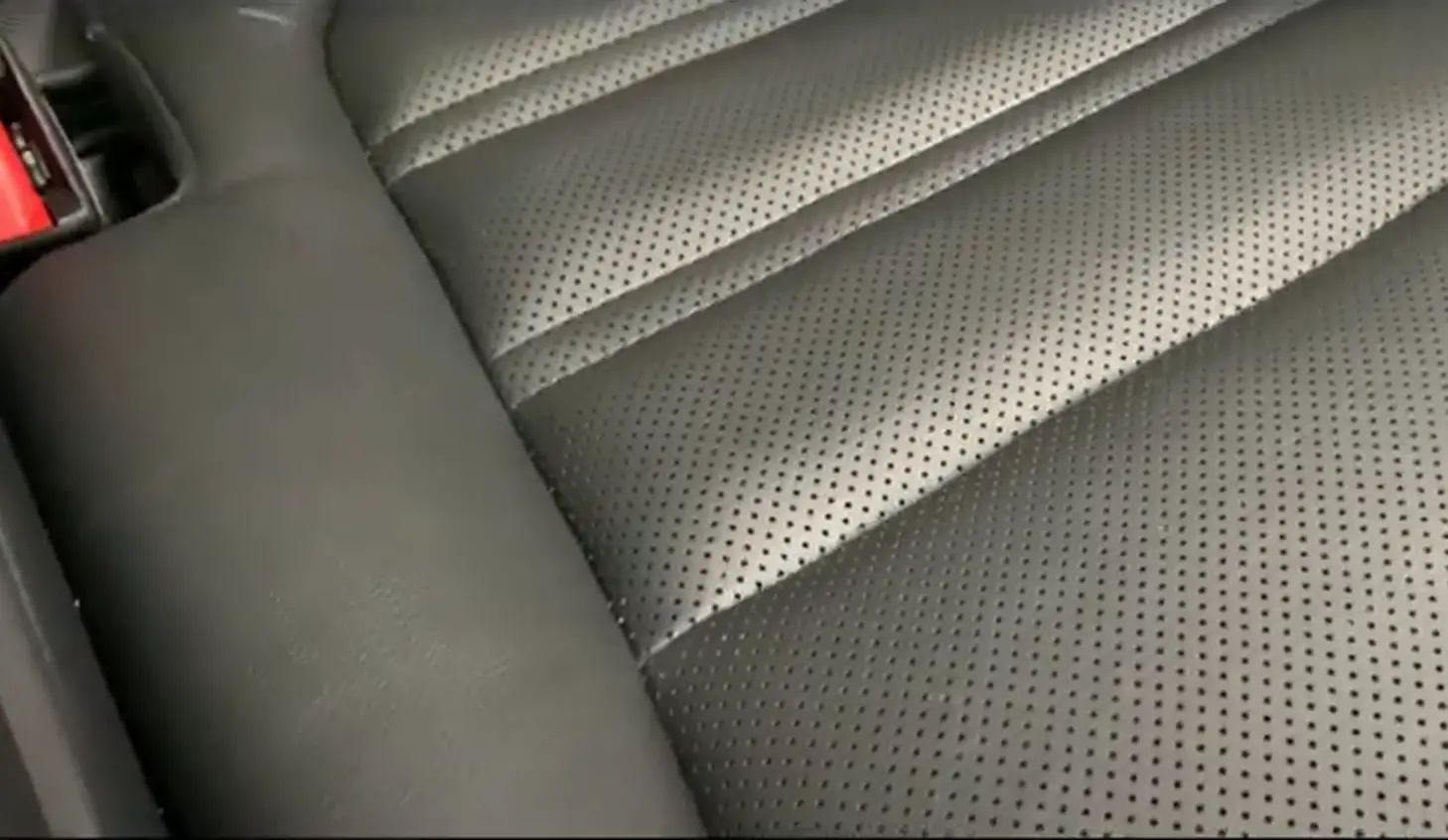
If all else fails, you can always take your car seats to a professional leather cleaner. They will have the proper equipment and knowledge to get your seats looking and smelling like new again!
Regular Maintenance For Perforated Leather Car Seats
In order to keep your perforated leather car seats looking their best, it’s important to perform some regular maintenance. This includes cleaning them on a regular basis and conditioning them every few months.
To clean your car seats, use a soft cloth or sponge and a gentle cleaner made for leather. Be sure to read the instructions on the bottle carefully so that you don’t damage the surface of your seats.
If the seat is very dirty, you can also make a solution of water and vinegar (one part each) and apply it with a spray bottle. Wipe away any excess moisture with a dry cloth afterward.
Conditioning your car seats is an important step in keeping them looking new. There are many different types of leather conditioners available, so be sure to choose one that is specifically made for perforated leather. Apply it according to the directions on the bottle, and allow it to dry completely. This will help protect your seats from spills and dirt buildup, and will keep them looking like new for years to come!
Comparison of Cleaning Methods for Perforated Leather Seats
This table provides a comparison of various cleaning methods for perforated leather seats. Perforated leather seats are commonly found in vehicles and require special care to ensure they remain clean and well-maintained. The table presents different indicators to consider when selecting a cleaning method, such as effectiveness, ease of use, and recommended frequency of application.
| Method | Effectiveness | Ease of Use | Recommended Frequency |
|---|---|---|---|
| Vacuuming | Good | Easy | Once a week |
| Brush and Wipe | Fair | Moderate | Every two weeks |
| Foam Cleaner | Excellent | Moderate | Once a month |
| Leather Conditioner | Good | Moderate | Every three months |
| Professional Cleaning | Superb | Difficult | Once a year |
The table provides a breakdown of different cleaning methods for perforated leather seats and their respective indicators. Here’s an explanation of each indicator:
- Method: Describes the cleaning method being compared.
- Effectiveness: Indicates the effectiveness of the cleaning method in removing dirt, stains, and odor from perforated leather seats. It is categorized as “Good,” “Fair,” “Excellent,” or “Superb.”
- Ease of Use: Rates the level of ease associated with implementing the cleaning method. It is categorized as “Easy,” “Moderate,” or “Difficult.”
- Recommended Frequency: Suggests how often the cleaning method should be applied to maintain clean and well-preserved perforated leather seats. It is given in terms of time intervals such as “Once a week,” “Every two weeks,” etc.
By considering these indicators, individuals can make an informed decision about which cleaning method suits their needs and preferences for keeping perforated leather seats in top condition.
FAQ
How do you clean vomit out of a perforated leather seat?
Vomit is a problem for any kind of leather and you need to act quickly. There are two big concerns when trying to clean vomit from perforated leather seats: the liquid/vomit getting into the cracks between the holes, or through small punctures in your seat’s surface.
And, it can be difficult to dry properly because air cannot get all the way down into those little holes where wetness has been deposited. Both situations lead to mold growth that ruins your car seat forever!
Follow these steps if there is only a minimal amount of puke on your upholstery:
- First, try using paper towels and then soft rags soaked with soapy water (some people prefer dish soap);
- Always keep cleaning material moving as you work to prevent cross-contamination;
- After you’re satisfied that most of the liquid has been removed, use a soft brush or absorbent rags and wipe with clean water again;
- Finally, blot dry your seats using paper towels first (to get up excess moisture) followed by microfiber cloths which will wick away any remaining wetness without leaving lint behind;
Are perforated leather seats better?
Most perforated leathers are higher-quality than solid hides and are both more durable (harder to tear) and softer in appearance.
Perforation can be made by many methods, but the primary goal is always uniform spacing of the holes from top to bottom.
Typically, thinner gauge material will have smaller diameter holes while thicker gauges may require larger hole diameters for achieving proper “breathability”. Oftentimes manufacturers use a combination of various sized openings as well: some small near your body for ventilation, others large enough so you don’t feel them when sitting on them. The seat cover shown here uses different size perforations at each end – what this means is that there’s less give along the edges versus in the center.
Leather is a natural material and as such, some areas may be more porous than others that will result in different rates of absorption.
Some people believe that perforated leather seats are cooler to sit on in hot weather because air circulates better around your body – this has yet to be proven scientifically. All things considered, it’s really up to personal preference whether you choose solid or perforated hide for your car seats. Whichever you decide, just make sure they’re well taken care of so they’ll last longer!
Can you steam clean perforated leather?
Yes, you can steam clean perforated leather but the same precautions need to be taken as with solid leather seats. Make sure that you use a very light touch and do not allow the steamer to sit in one place for too long – this could damage your seat cover. Go over the entire surface evenly and if there are any areas where the perforation is especially sparse, use a soft brush to help loosen any dirt or debris. Follow up by blotting dry with paper towels and then a microfiber cloth. Voilà! Your seats are looking like new again!
As an alternative method for getting up large chunks:
- Place paper towels over the surface area and then gently press using your fingers followed by light pressure using clean cloths soaked in soapy water;
- This way you won’t push crumbs or other types of dirt farther into the cracks;
- When everything is dry, wipe off with a soft cloth to remove any residual moisture. If you can’t see dust particles on your seats anymore then they’re clean enough;
If there’s no way possible to avoid perforated leathers during renovation/construction work, try using an opaque plastic sheeting over your car seat as shown above – cover one side only and make sure it overlaps onto surrounding areas so that nothing falls through which could potentially get stuck inside the crevices.
Then use tape around every edge of said covering in order to keep it from falling down unexpectedly when someone sits on it. If you still see dust particles or residue after pulling the sheeting away, repeat this process until there’s nothing left!
Can you clean leather seats with vinegar?
Leather seats may be cleaned with any number of cleansers, but white vinegar works best. If you mix it incorrectly, white vinegar might dry out leather. Linseed oil and vinegar should both be combined in equal parts before being dabbed on and gently brushed away with a towel or a clean toothbrush or soft-bristled brush [4].
Is perforated leather waterproof?
No, perforated leather is not waterproof and should not be used in areas that may come into contact with water. If liquid seeps through the tiny holes, it could cause damage to the underlying material. Try using opaque plastic sheeting as mentioned earlier to protect your seats from accidental spills.
Maintaining proper ventilation is still important even if you’re using a cover; too much moisture will create an ideal environment for mold and other types of bacteria to grow.
Make sure that any cleaning products you use are specifically meant for leather – harsh chemicals or solvents can strip away the protective finish over time and leave your seats vulnerable to staining and fading.
What should I avoid when cleaning perforated leather seats?
While cleaning perforated leather seats, there are certain things you should avoid to prevent damage. Here are a few things to keep in mind:
- Avoid using harsh chemicals: Harsh cleaners, such as bleach, ammonia, or abrasive cleaners, can damage the leather and cause it to dry out or discolor.
- Avoid excessive moisture: While it’s important to clean the seats, using excessive moisture or soaking the perforations can lead to mold or mildew growth. Use a minimal amount of cleaner and ensure the seats are thoroughly dried after cleaning.
- Avoid rough materials: When scrubbing the seats, use a soft-bristle brush or a microfiber cloth. Rough materials like scrub brushes with stiff bristles or abrasive sponges can scratch or damage the leather.
- Avoid direct sunlight and heat sources: Exposing perforated leather seats to direct sunlight or heat sources, such as hairdryers or heaters, can cause the leather to dry out, crack, or fade.
By avoiding these potential pitfalls, you can ensure that your perforated leather seats remain in excellent condition for a long time.
How can I prevent stains on perforated leather seats?
To prevent stains on your perforated leather seats, it’s important to take some preventive measures. Here are a few tips:
- Regular cleaning: Perform regular cleaning of your perforated leather seats using a mild leather cleaner. This helps remove dirt, oils, and other substances that can lead to stains.
- Quick action: If a spill occurs, it’s crucial to act quickly. Use a clean, absorbent cloth or paper towel to blot the spill gently. Avoid rubbing, as it can push the liquid further into the leather and cause a stain.
- Protective products: Consider applying a leather protectant or conditioner specifically designed for perforated leather. These products can create a protective barrier that repels liquids and makes it easier to clean up spills before they can stain the seats.
- Proper maintenance: Keep your perforated leather seats well-maintained by regularly applying a leather conditioner. This helps keep the leather supple and prevents it from drying out, which can make it more prone to stains.
By following these preventive measures, you can minimize the chances of stains and keep your perforated leather seats looking clean and fresh.
Can I use a steam cleaner on perforated leather seats?
No, it’s generally not recommended to use a steam cleaner on perforated leather seats. The steam can penetrate the perforations and potentially damage the underlying foam or padding, leading to mold or mildew growth. Additionally, the high heat from the steam can cause the leather to shrink or become distorted.
It’s best to stick to cleaning methods that involve gentle brushing, wiping, and using mild leather cleaners specifically designed for perforated leather. These methods are safer and less likely to cause any damage to the seats.
What are some alternative cleaning methods for perforated leather seats?
If you’re looking for alternative cleaning methods for perforated leather seats, you can consider the following:
- Using a leather cleaning solution: Look for a reputable leather cleaning solution that is safe to use on perforated leather. Follow the instructions provided by the manufacturer to effectively clean the seats.
- Using a leather cleaning wipe: Some manufacturers offer pre-moistened leather cleaning wipes specifically designed for convenience and ease of use. These wipes often contain mild cleaning agents that can help remove dirt and stains from the seats.
- Seeking professional cleaning: If your perforated leather seats require a more thorough or specialized cleaning, it may be wise to consult a professional leather cleaning service. They have the expertise and equipment to clean and condition the seats effectively.
Remember to always test any alternative cleaning method or product in a small, inconspicuous area before applying it to the entire seat to ensure it doesn’t cause any damage or discoloration.
How do I maintain the condition of my perforated leather seats?
Maintaining the condition of your perforated leather seats is essential to keep them looking great for years to come. Here are some tips for proper maintenance:
- Regular cleaning: Clean your perforated leather seats regularly using a mild leather cleaner and a soft-bristle brush. This helps remove dirt, oils, and other contaminants that can accumulate and cause damage over time.
- Conditioning: Apply a high-quality leather conditioner specifically formulated for perforated leather seats. This helps moisturize and nourish the leather, preventing it from drying out and cracking.
- Protection from sunlight: Whenever possible, park your vehicle in shaded areas or use window shades to protect the seats from direct sunlight. Prolonged exposure to sunlight can cause the leather to fade and become brittle.
- Avoid sharp objects: Be mindful of sharp objects such as keys, belt buckles, or metal accessories that could scratch or tear the perforated leather. Take care when entering or exiting the vehicle to minimize the risk of accidental damage.
By following these maintenance tips, you can extend the lifespan of your perforated leather seats and keep them looking luxurious and well cared for.
Useful Video: Trick to cleaning perforated leather car seats
References:
- https://www.charmcitycirculator.com/clean-perforated-leather-car-seats
- https://cardetailingplanet.com/clean-perforated-leather-seats-in-car/#1-air-compressor
- https://carseatsmom.com/clean-perforated-leather-car-seats
- https://www.countryliving.com/home-maintenance/cleaning/a30392657/how-to-clean-car-seats

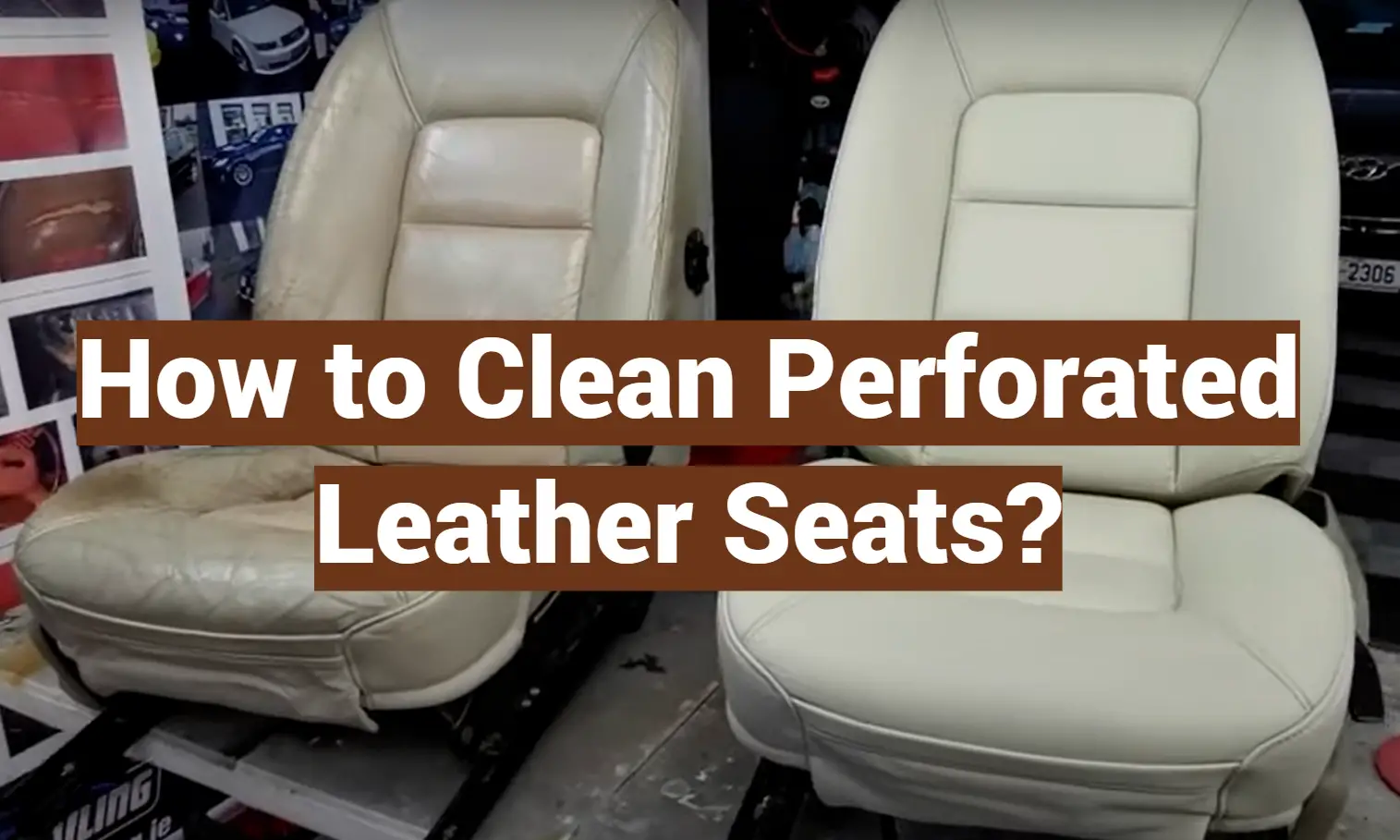
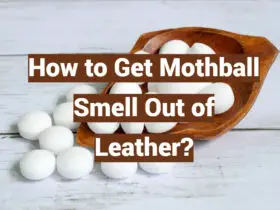

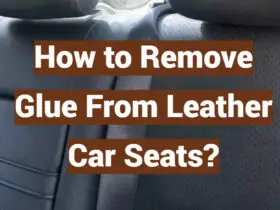


The best way I’ve found to clean my perforated leather seats is with a soft brush and mild soap and water solution. I dip the brush in the soapy water and gently scrub the seats in a circular motion. This gets into all the little holes and crevices well. Just be sure to avoid using anything too harsh on the leather.
I struggled for so long to get the funky odor out of my perforated leather seats. What finally worked was sprinkling baking soda all over and letting it sit for a few hours to absorb the smell before vacuuming it up. It made a huge difference and absorbed a lot of those tough odors from the perforations.
My favorite tool for cleaning my perforated leather car seats is a soft-bristled detailing brush. It allows me to gently scrub the seats and get into the perforations without damaging the leather. I like to use it with some leather cleaner and it lifts dirt easily from the uneven surface of the seats. It’s a must-have for maintaining perforated leather.
When cleaning perforated leather seats, it’s important to avoid getting the perforations clogged up. I use the hose attachment on my vacuum to suck up any loose debris first. Then I use a soft damp microfiber cloth to wipe down the seats in circular motions. This gets them clean without pushing grime into the holes.
I learned the hard way that you have to be really diligent about cleaning perforated leather car seats. Once crud starts building up in the holes, it’s tough to get out. Now I wipe my seats down weekly so grime doesn’t have a chance to accumulate. A mild cleaner and soft brush does the trick for maintenance cleaning.
For a deep clean of my perforated leather car seats, I mix warm water and a gentle soap in a spray bottle. I liberally spray the seats, let it soak for a minute, then scrub with a soft bristle brush. The soap lifts dirt from the perforations without harming the leather. It makes a huge difference in cleaning the seats thoroughly.
I love my leather car seats but the perforations make them tricky to clean. I’ve found that using a lightweight vacuum attachment is perfect for sucking up loose debris without pushing it further into the holes. Regular vacuuming keeps my perforated seats looking great in between deeper cleanings.
Getting perforated leather seats perfectly clean seems impossible but I’ve discovered some tricks. Always start by vacuuming up any loose dirt. Then use a soft detailing brush and mild soap to scrub the seats. The key is being gentle enough not to damage the leather while still getting grime out of the holes. Patience pays off!
Through trial and error, I’ve learned the best way to clean perforated leather car seats is by mixing equal parts warm water and white vinegar in a spray bottle. I liberally spray the solution onto the seats, let it soak for a few minutes, then wipe clean with microfiber towels. The vinegar disinfects and cuts through grime.
I used to just spot clean my perforated leather car seats but realized that wasn’t enough. Now I thoroughly clean the whole surface by wiping down with leather cleaner first, then using a small detailing brush to scrub the holes. Getting the perforations completely clean takes some work but makes a huge difference in appearance.
For stubborn odors and grime, I rely on my perforated leather cleaner. I spray it onto my car seats, let it soak in for 5 minutes, then wipe clean with a microfiber cloth. It’s formulated specifically for perforated leather and gets deep into the holes better than regular cleaners. Well worth the investment for cleaner seats!
The most important tip I’ve learned for cleaning perforated leather car seats is to be patient and gentle. Aggressive scrubbing can damage the leather. I use a soft brush and mild cleaner to lightly clean. Taking my time ensures a thorough clean without harming the perforations or leather.